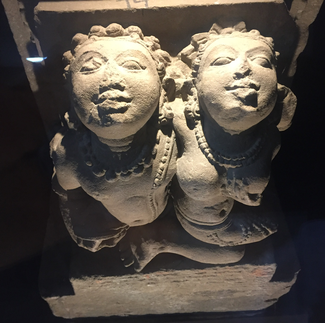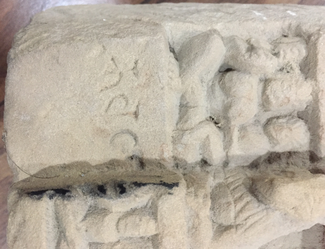The Muslim Discovery of India
Robert Hoyland
Professor of Late Antique and Early Islamic Middle Eastern History
This article first appeared in ISAW Newsletter 22 (Fall 2018).
 Sculptures of the early medieval period from the Museum of Archaeology of Kannauj
What peoples and cultures did the Muslim Arabs encounter when they entered northern India in the eighth century from their newly acquired base in the lower Indus Valley, in modern Pakistan? This is the question that I am trying to answer for my next project. It is not an easy question. For the educated Muslim elite of Baghdad, the Indus Valley was remote and alien, and on the rare occasions that reports of it reached the Muslim capital they had generally acquired a somewhat fabulous quality. On the Indian side, the powerful Gupta Empire that dominated the north of the subcontinent from the fourth to the sixth centuries AD had imploded and been replaced by numerous regional princes and warlords, who were not interested in commissioning chronicles. Piecing together the history of this world therefore requires some detective work.
Sculptures of the early medieval period from the Museum of Archaeology of Kannauj
What peoples and cultures did the Muslim Arabs encounter when they entered northern India in the eighth century from their newly acquired base in the lower Indus Valley, in modern Pakistan? This is the question that I am trying to answer for my next project. It is not an easy question. For the educated Muslim elite of Baghdad, the Indus Valley was remote and alien, and on the rare occasions that reports of it reached the Muslim capital they had generally acquired a somewhat fabulous quality. On the Indian side, the powerful Gupta Empire that dominated the north of the subcontinent from the fourth to the sixth centuries AD had imploded and been replaced by numerous regional princes and warlords, who were not interested in commissioning chronicles. Piecing together the history of this world therefore requires some detective work.
This summer I have been polishing my Sanskrit after many years of neglect and applying it to two particular forms of evidence. The first is copper plates. These survive well in the wet climate of India and so were commonly used to record important transactions, and, usefully for us, their authors would often take the opportunity to boast of their accomplishments. For example, on a plate dated to 736 AD the king of Gujarat, after recording the details of a land grant, proclaims how he “forcibly vanquished the Arabs, who greatly opposed all people, just as a cloud extinguishes with its showers the fire that troubles all people”.
Only a short time later, a lord of the more powerful Chalukya kingdom to the south, sent troops to help his neighbors fight the Arabs and he likewise memorialized his victory in a document and described the battle in particularly vivid terms, speaking of “the torrents of blood from innards that had burst out from the heavy bellies of great warriors” and of “the turbans and trenchant swords reddened by a thick veil of blood that had poured from wounds in the trunks and cheeks of enemy elephants”.
 Sculptures of the early medieval period from the Museum of Archaeology of Kannauj
The territories of these two monarchs lay either side of the Gulf of Cambay (modern Khambhat, north of Bombay), through which many ships passed on their way to the ancient port of Barygaza, and so it is likely that the Arabs were trying to extend their control over international trade routes in the Indian Ocean.
Sculptures of the early medieval period from the Museum of Archaeology of Kannauj
The territories of these two monarchs lay either side of the Gulf of Cambay (modern Khambhat, north of Bombay), through which many ships passed on their way to the ancient port of Barygaza, and so it is likely that the Arabs were trying to extend their control over international trade routes in the Indian Ocean.
The second type of evidence is sculptures, usually from religious contexts, which tell us about beliefs and aesthetic traditions of the local culture and, if we are lucky, bear informative inscriptions. I spent some time at Kannauj, south of Delhi, which was the capital of one of those regional kingdoms that emerged out of the rubble of the Gupta Empire. The Chinese pilgrim Xuanzhan, who visited in the 630s, tells us of its “lofty structures, beautiful gardens and reservoirs of clear water”, where many Buddhist and Hindu monasteries flourished. Some sculptures that survived from these monasteries have been collected and sensitively displayed at Kannauj’s archaeological museum (under the expert directorship of Deepak Kumar). Some date to the early medieval period (7-9th centuries AD) and my current intention is to study and record as many of these as possible in the hope that, cumulatively, they and other objects of local provenance will enable me to form a picture of the world that the Muslim Arabs found when they first began to have dealings in northern India.